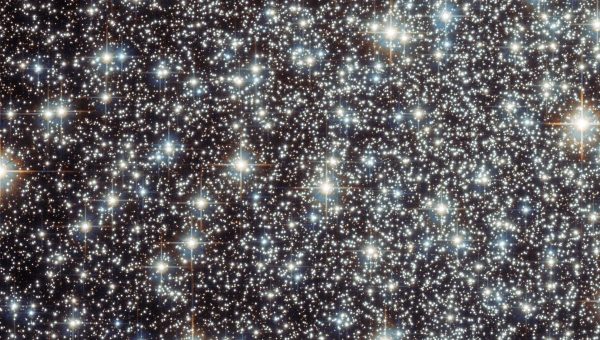A globular cluster for the new year: M22 – SYFY WIRE
Contributed by
Jan 1, 2020
Happy new year!
Usually on this day I repost an updated version of my article on what we mean by “year,” which is way more complicated than you might think. But this time I decided to give it a rest, and instead post a pretty picture of something.
But what? Choices abound, but then I thought, well, where is the Sun in the sky on New Year’s Day? As the Earth orbits the Sun, we see the Sun move against the background stars, so every day it’s in a slightly different spot relative to the stars. So why not see if there’s an interesting object near where the Sun is today, and write about that?
It’s as good a way as any to find something cool to write about. So I fired up , entered 1 January 2020, and took a look at where the Sun was. And lookee here: On New Year’s Day the Sun is just a couple of degrees from the globular cluster M22 … which has been observed by Hubble! Perfect! :
Hubble Space Telescope observation of the globular cluster M22 in Sagittarius, one of the closest such objects at a distance of about 10,000 light years. Credit: E
Well, that’s better than fireworks on New Year’s Eve.
are tight collections of tens of thousands of stars, and some have upwards of a million. They tend to be nearly spherical (hence the name) and very densely packed in their centers, gradually fading away with distance. Despite their incredible population, they aren’t all that big, with most being just a few dozen light years wide. Bear in mind that the nearest neighbor to the Sun is the Alpha Centauri triple system, and that’s over 4 light years away! The same volume would have thousands of stars in it in the center of a globular.
Globulars orbit the galaxy as a whole, and some are really far away and difficult to see. M22 is a close one, though, at around 10,000 light years distant. It’s technically visible to the naked eye, though far enough south in the sky that for northern observers it can be a tough one to spot. It’s easy in binoculars, though. Of course, not right now as I post this, since the Sun is just two degrees away! But in six months or so when Sagittarius is high in the sky after sunset you should give it a try.
Here’s something interesting I didn’t know until I was reading about M22: , in 1665! Charles Messier found it himself somewhat later, including it in his famous catalog of bright deep sky objects (which he compiled because they irritated him, since he was a comet hunter and they look like comets in a small telescope). It wasn’t until quite some time after that the true nature of the object was found.
… though it’s arguable we don’t know their true nature just yet. For a long time it was thought globulars formed along with galaxies 10 or so billion years ago, collapsing all at once from huge gas clouds. That meant all the stars were the same age, making them ideal labs to understand how stars evolve over time. But then some were found with two different populations of stars at two different ages, and it became clear some of our assumptions about them weren’t right. And now we know that some (like the ginormous Omega Centauri) were likely the cores of small galaxies eaten by the Milky Way! What we see left is the tightly bound core of the galaxy, which hasn’t yet been pulled apart by our much larger galaxy.
The Sun’s position on 1 January 2019 is very close to the location of the globular cluster M22 (crossed cirlce), separated by a little over 2 degrees. The yellow line is the path of the Sun through the sky during the year, and it passes M22 closest on 29 Dec. Credit: Sky Safari
Here’s a fun thing about scientists: We love to have to rewrite the textbooks. It means we learned something new. It makes things harder to understand sometimes, but it also means there are layers, nuances, complexities we didn’t grasp before but which we can now start to appreciate. And it means the story of our Universe is that much more interesting. That much more beautiful.
And you know what? That’s a pretty good thought to start a new year with. Make yours a good one.









